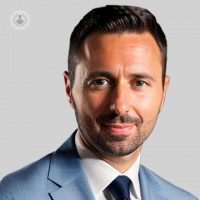Navigating brain tumour recovery
Written by:Neuroimages post-treatment are like before-and-after snapshots, vital for monitoring brain tumour impact. Neuroradiologists face the challenge of distinguishing tumour relapse from treatment effects. In his latest online article, Professor Sotirios Bisadas explores advanced imaging techniques, follow-up frequency, and the role of technology and skilled neuroradiologists in accurate diagnosis.

How can neuroradiology differentiate between tumour relapse and treatment-related effects?
Neuroimages taken before and after your treatment are like "before and after" pictures in a canvas makeover. They show changes in your brain over time. Neuroradiologists are skilled doctors who can spot different patterns and shapes in these images. Some changes might look like the tumour is back, while others may suggest it's just the side effects of your treatment. We also pay attention to when these changes happen. If something unusual shows up soon after treatment, it might be a side effect. But if it appears much later, it could be a sign that the tumour is trying to make a comeback. Sometimes, we may use other tests, like biopsies or special scans, to get a clearer picture. The goal of all this work is to make sure we're making the right call. If it's a relapse, we'll tackle it immediately with a new treatment plan. If it's just treatment-related effects, your care will be adjusted to make you more comfortable.
Are there advanced imaging techniques that offer better clarity in distinguishing between tumour relapse and treatment effects?
Imagine you're exploring a dense forest, and you need the best tools to find your way. In the world of neuroradiology, we have some unique tools to help us distinguish between tumour relapse and treatment effects. To start with, we use advanced imaging sequences. These allow us to see deeper into your brain. We use techniques like "perfusion imaging" and "diffusion-weighted imaging" to watch how blood flows and molecules move or how dense the nerve cells are packed. This helps us spot subtle differences that might tell us whether it's the tumour coming back or just the aftermath of treatment. Furthermore, Positron Emission Tomography (PET) scans show us how your brain cells are using energy and amino acids to build proteins needed to grow up. If they're overly active in a particular area, it might be a sign of a tumour. But if things show low or no activity at all, it could just be the treatment effects settling down. Magnetic Resonance Spectroscopy (MRS) helps us analyse the chemical makeup of your brain tissue. Different substances give us clues about what's happening inside. If we see certain chemicals that usually hang around with tumours, it could be a sign of relapse. Finally, comparing with previous scans is very useful: Just like a treasure map, we use your older scans as references. By comparing current scans with those from before treatment, we can spot changes more accurately. Sudden shifts are like hidden clues we need to investigate further.
How frequently should follow-up imaging be conducted to monitor for potential relapse or treatment-related effects?
This is the art of keeping watch, in malignant tumours we don't want to check too often and create inconvenience and distress for you, but we also don't want to wait too long and miss any changes. Right after treatment, we keep a close eye on things. We might do scans every 3 months to see how your brain is responding. As time goes on and everything seems stable, we can space out the checks a bit. We might do scans every 4-6 months to make sure everything stays on track. In benign tumours that have been successfully treated, the MRI interval can be up to 12 months or depending on your unique situation even longer. Regular checks help us catch any potential issues early, whether it's a relapse, treatment response, or treatment-related effects. It's all about finding the right balance to cure you.
What role does advanced imaging technology and skilled neuroradiologists play in improving the accuracy of distinguishing between tumour relapse and treatment-related changes?
Imagine you're embarking on a treasure hunt, and you have the most cutting-edge tools and a team of experts by your side. That's what advanced imaging technology and skilled radiologists are for your journey. These tools give us incredibly clear and detailed pictures of your brain. Techniques like perfusion imaging and diffusion-weighted imaging help us spot any hidden clues and understand the underlying mechanism of action in the tumours. Taking advantage of modern AI tools, we become more efficient in comparing current scans with older ones to spot even the tiniest changes. These state-of-the-art tools are valuable in the hands of skilled neuroradiologists. These are like your seasoned explorers in the treasure hunt, who know every twist and turn of the terrain. They've seen countless scans and can identify even the subtlest differences. They can recognise patterns that might tell us whether it's a relapse, treatment effects, or your body responding positively to treatment. Having these advanced tools and experts on your side makes all the difference. The fundings guide the multidisciplinary neuro-oncology team in adjusting your treatment plan to ensure the best possible outcome on your health journey.
Professor Sotirios Bisdas is an esteemed neurodiologist. You can schedule an appointment with Professor Bisadas on his Top Doctors profile.


